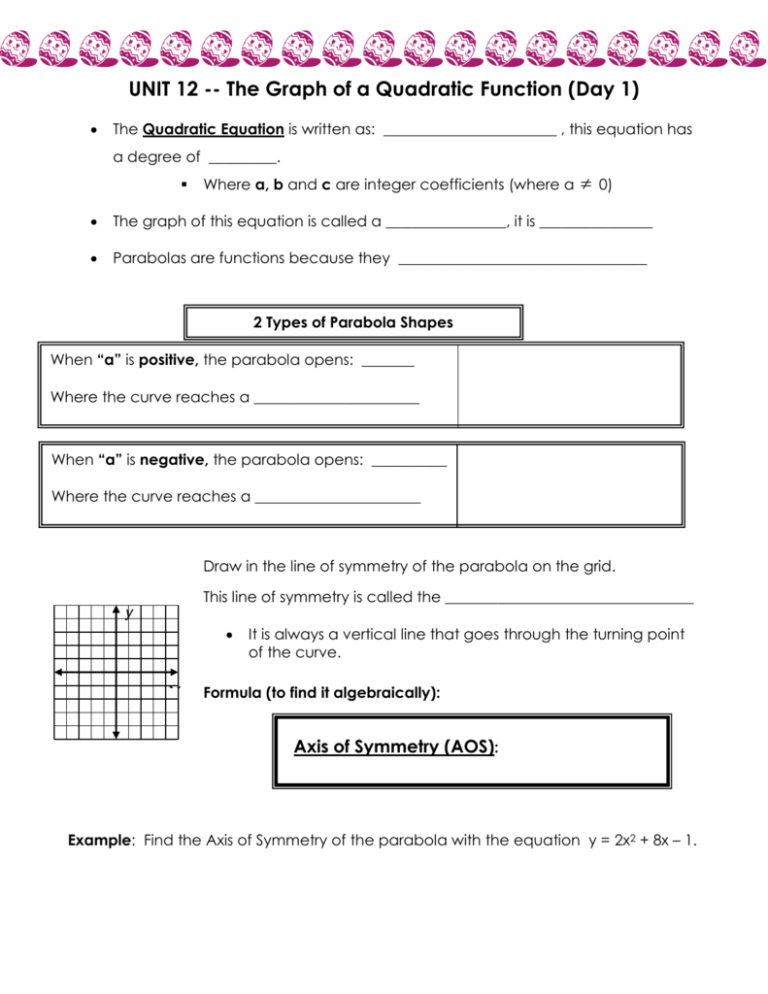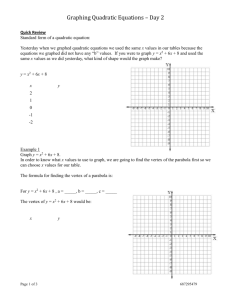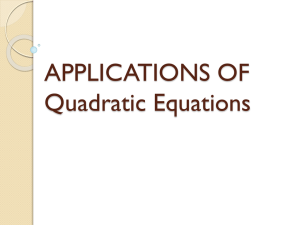Graphing Quadratic Functions (Day 2)
advertisement

UNIT 12 -- The Graph of a Quadratic Function (Day 1) The Quadratic Equation is written as: _______________________ , this equation has a degree of _________. Where a, b and c are integer coefficients (where a 0) The graph of this equation is called a ________________, it is _______________ Parabolas are functions because they _________________________________ 2 Types of Parabola Shapes When “a” is positive, the parabola opens: _______ Where the curve reaches a ______________________ When “a” is negative, the parabola opens: __________ Where the curve reaches a ______________________ Draw in the line of symmetry of the parabola on the grid. This line of symmetry is called the _________________________________ y x It is always a vertical line that goes through the turning point of the curve. Formula (to find it algebraically): Axis of Symmetry (AOS): Example: Find the Axis of Symmetry of the parabola with the equation y = 2x2 + 8x – 1. Turning Point: Is another term for the vertex of the parabola. The “vertex” has the coordinates of x, y . y What appears to be the turning point of the parabola on the left? Is it a minimum or maximum? x To Find Turning Point (T.P.) - algebraically --_____________________________________________________________________ _____________________________________________________________________ -- ____________________________________________________________________ Example: Find the Axis of Symmetry and Turning Point for y = -x2 + 4x – 5. Roots of the equation are the points where the parabola y _____________________ the x – axis, so y = _________. x What are the roots of the parabola on the grid to the left? ______________ 2 Graphing Quadratic Functions (Day 2) How to Graph Parabolas: 1. Find the axis of symmetry by using the formula. 2. Substitute the x value back into the equation to find the turning point and describe it as a max or min pt. 3. Make a table of values. 4. Graph the points. Example 1: Graph y x 2 4x Example 2: Graph y x 2 2x 3 ( 4 x 2 ) This is called an interval, which means your table should cover the x-values from -4 to 2. 3 Exploring the Graphed Quadratic Equation (Day 3) Quadratic functions are written in the form: ______________________________ The x – intercepts (when y = 0) of the parabola y ax2 bx c are called the _________________ or _________________ of the equation ( ax2 bx c 0 ) How many roots are possible to obtain from a quadratic equation? Draw a picture to illustrate each situation y y y x x x Example 1: Given the following graph of the equation y = x2 – 7x + 10, answer the following questions. ONLY LOOK AT THE GRAPH TO ANSWER THE QUESTIONS! What is the axis of symmetry? __________ What are the coordinates of the turning point?________ Is the T.P. a max or minimum point? ________ How many roots are there?__________ What are the solutions of this equation? ________ What are the solutions called? ________ Now, solve this equation by factoring and t-charting: 0 = x2 – 7x +10 What do you notice? ________________________________________________________ 4 Example 2: Graph y x 2 6x 5 What is the axis of symmetry? __________ What are the coordinates of the turning point?_______ Is the T.P. a max or minimum point? ________ How many roots are there?__________ What are the solutions of this equation? ________ What do you call these solutions? __________ Now try to solve the above equation algebraically! How do we do this? STEPS for below (Working Backwards): 1) Find Roots (where graph crosses x-axis). 2) Put roots into factored form. 3) Do FOIL. 4) Put into correct quadratic equation form (watch out for open down parabolas like Ex. 4). Write an equation for each graph below. Ex.3 Ex.4 5 Solving Quadratic – Linear Systems (Day 4) Two equations will be given to you with the directions to solve the system graphically. One equation will be a quadratic. This equation has degree ________ The second equation will be linear. This equation has degree ________ You will have to create a table of values for the quadratic equation and graph the linear equation using __________________________________________. Where the two graphs _____________________, this is your ______________________. There are three possible situations as answers illustrated below. Indicate the number of solutions in each representation. Examples: 1. Solve the following system of equations graphically and check. y x 2 4x 3 x y 1 To check on your GRAPHING CALCULATOR (find intersection): 1) Go to 2nd 2) Move cursor to desired intersection point Trace (Calculate) and pick 6 #5 Enter (intersection) Enter Enter 2. Solve the following system of equations graphically and check. y x 2 4x 4 y 2 x 4 3. The graphs of the equations y x 2 and x 2 intersect in: (1) 4. 1 point (2) 2 points (3) 3 points (4) 4 points (4) (6, 0) Which is a solution of the following system of equations? y 2 x 15 y x 2 6x (1) 5. (3, –9) (2) (0, 0) (3) (5, 5) When the graphs of the equations y x 2 5x 6 and x y 6 are drawn on the same set of axes, at which point do the graphs intersect? (1) (4, 2) (2) (5, 1) (3) 7 (3, 3) (4) (2, 4) Solving Quadratic – Linear Systems Algebraically (Day 5) Two equations will be given to you with the directions to solve the system algebraically One equation will be a quadratic. This equation has degree ________. The second equation will be linear. This equation has degree ________. Steps: 1. Make sure both equations are in y = form if necessary. 2. Substitute the linear equation into the ‘y part’ of the quadratic equation, to have only one variable left to solve in the equation. 3. Get NEW quadratic equation into standard form (____________________________) and ___________________________________________________. 4. Since it is a quadratic: Must FACTOR TO SOLVE FOR X. (How many answers should you get?_______) 5. Must find other variable (y) by substituting your ‘x’ answers into one of the equations and solving for y. 6. Check solutions. Examples: 1. Solve the following system: y x2 x 2 y 2x 8 2. Find the solutions of: 3. Solve for the solutions: y x 2 4x 3 x y 1 y x 2 7x 13 xy 2 9 Applications with Parabolic Functions (Day 6) Example 1: The graph at the right shows the height h in feet of a small rocket t seconds after it is launched. The path of the rocket is given by the equation: h = –16t2 + 128t. 1. How long is the rocket in the air? _________ h (height (feet)) 250 200 2. What is the greatest height the rocket reaches? ______ 3. About how high is the rocket after 1 second? _______ 4. After 2 seconds, a. about how high is the rocket?_________ b. is the rocket going up or going down? ________ 5. 150 100 50 After 6 seconds, a. about how high is the rocket? _______ b. is the rocket going up or going down? ________ 1 2 3 4 5 6 time (seconds) 6. Do you think the rocket is traveling faster from 0 to 1 second or from 3 to 4 seconds? Explain your answer. 7. Using the equation, find the exact value of the height of the rocket at 2 seconds. 8. What is the domain of the graph? 9. What is the range of the graph? 10. Express the interval over which the graph is increasing. 11. Express the interval over which the graph is decreasing. 10 7 8 Example 2: A ball is thrown in the air. The path of the ball is represented by the equation h = –t2 + 8t. Graph the equation over the interval 0 t 8 on the accompanying grid. height (meters) 12. What is the maximum height of the ball? 13. How long is the ball in the air? 14. What is the range of heights the ball travels? 15. Which interval is the ball traveling the fastest? (1) [0, 2] (2) [2, 4] time (seconds) (3) Why? 16. Over what interval of time is the ball above 7 meters? 11 [4, 6] Solving Quadratic App. Word Problems Algebraically (Day 7) Things to remember when completing quadratic application word problems: t is____________. It represents _______. h or d is _______________/distance. It represents ________. When an object hits the ground (water), its height = 0. When asked for Max/Min height, that is the _________________________ of the parabola. 1. After t seconds, a ball tossed in the air from the ground level reaches a height of H feet given by the equation H(t) = 144t – 16t2. a. What is the height of the ball after 3 seconds? b. What is H(4)? c. What is the maximum height the ball will reach? d. Find the number of seconds the ball is in the air when it reaches a height of 224 feet. e. After how many seconds will the ball hit the ground before rebound? 12 2. 3. A rocket carrying fireworks is launched from a hill 80 feet above a lake. The rocket will fall into the lake after exploding at its maximum height. The rocket’s height above the surface of the lake is given by h = –16t2 + 64t + 80. a. What is the height of the rocket after 1.5 seconds? b. What is the maximum height reached by the rocket? c. How long will it take for the rocket to hit 128 feet? d. After how many seconds will the rocket hit the lake? A rock is thrown from the top of a tall building. The distance, in feet, between the rock and the ground t seconds after it is thrown is given by d = –16t2 – 4t + 382. How long after the rock is thrown is it 370 feet from the ground? 13









